
ACT Science Practice Test 36 - Bài kiểm tra khoa học số 36
Từ khoá: ACT Science ACT Practice Test 36 luyện thi ACT đề thi ACT Science phân tích biểu đồ đọc hiểu khoa học kỹ năng tư duy phản biện luyện thi đại học Mỹ bài tập ACT đề có đáp án
Đề thi nằm trong bộ sưu tập: Tuyển Tập Bộ Đề Thi Đại Học Hoa Kỳ (ACT) - Có Đáp Án Chi Tiết
Số câu hỏi: 23 câuSố mã đề: 1 đềThời gian: 1 giờ
195,971 lượt xem 15,070 lượt làm bài
Xem trước nội dung:
Ever since Darwin proposed his theory of natural selection in 1859, biologists have regarded the gene as the sole unit of inheritance, and the discovery of DNA in the twentieth century only served to reinforce this view, known as “hard inheritance.” The idea that environmental factors could produce heritable changes in an organism without altering the organism’s DNA (as occurs in gene mutation due to radiation exposure, for example), known as “soft inheritance,” had long been written off as an impossibility. “Inheritance of acquired traits” became a biological fallacy associated with pre-Darwinians like Jean-Baptiste Lamarck and fanatical Soviet scientists like Trofim Lysenko. But the very recent discovery of what has been termed epigenetics—biological mechanisms that leave DNA unchanged but can alter the ways in which individual genes express themselves—has opened the door on the possibility of “soft inheritance” once again, although many biologists remain skeptical.
Scientist 1
Although study of the so-called “epigenome” is worthwhile and possesses the potential to answer questions about a host of problems from diabetes to cancer, it would be premature to call true “soft inheritance” a reality, at least in animal species. Isolated situations in which environmental factors could affect an organism’s immediate descendants—a mother with a zinc deficiency producing children and grandchildren with weakened immune systems, for example—had already been documented without anyone ever suggesting that there was more to heritability than the gene. Immediate successive generations may exhibit observable effects, but the bloodline always reverts to the true expression of its DNA. A map with dust on it may be hard to read, but the information on the map remains unchanged, and it is simply a matter of how long it takes for a strong wind to blow away the dust.
Scientist 2
Someone who is determined never to see “true soft inheritance” will never see it, but that doesn’t change the fact that it occurs, and indeed has been occurring all along without our realizing it. Epigenetic mechanisms may not alter DNA, but they possess the ability to turn genes “on” or “off” for the duration of an organism’s bloodline, at least until such time as the genes are affected by another epigenetic mechanism. There is already compelling evidence, for example, that tobacco smoking poses risks not only to the individual smoker, but to all of his or her descendants. Imagine a three-way light bulb with three possible brightness settings being put into a three-way lamp on which one of the settings is broken. The fact that the bulb still possesses three settings is immaterial if it is permanently set into a broken lamp. It will continue to “express itself” in a limited way. And the same thing can happen to a gene. If environmental factors can permanently alter the way in which an unaltered gene expresses itself down along a bloodline, resulting in observable effects in the members of that bloodline, then what can we possibly call this other than true soft inheritance?
Scientist 2 would most likely disagree with the suggestion that genes:
Histones are proteins that attach themselves to sequences of DNA and can alter the expression of genes depending on whether they are acetylated or methylated. Given this information, it would appear that histones are analogous to the:
Figure 1 shows the average sleep pattern of a child, Figure 2 shows the average sleep pattern of a young adult, and Figure 3 shows the average sleep pattern of an elderly person. At Stage 0, the person is awake. As sleep moves from Stage 1 to Stage 4, it grows progressively deeper. REM sleep, commonly associated with dreaming, is predominant in the final third of a sleep cycle.
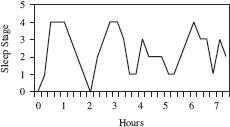
Figure 1
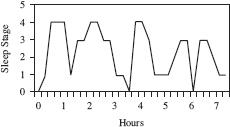
Figure 2
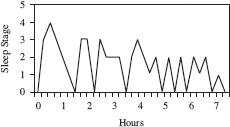
Figure 3
Tornado intensity is commonly estimated by analyzing damage to structures and then correlating it with the wind speed required to produce such destruction. This method is essential to assigning tornadoes specific values on the Fujita Scale (F scale) of tornado intensity (see Figure 1).
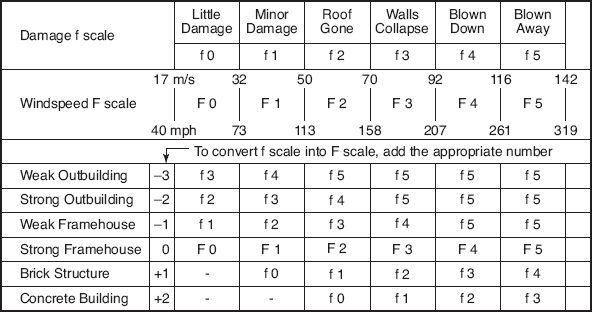
Figure 1
A tornado is formed when the following occurs: (1) warm, moist air rises into cool, dry air; (2) when the barrier is breached, a bulge of warm, moist air expands and condenses to form a cloud; (3) as air moves upward, the resulting instability creates a spiral of air called a mesocyclone; (4) cold air moves downward and rain falls as the cloud becomes a supercell; (5) cool, moist air from rain cycles back into a cloud, forming a spinning wallcloud; and (6) horizontal spiraling wind “tubes” are pushed upward by warm, moist air, forming a tornado. (See Figure 2.)
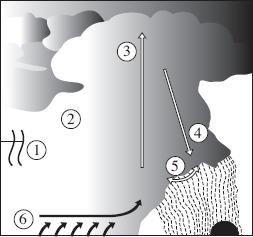
Figure 2
The United States has the most tornadoes of any country, and most of these tornadoes form in an area of the central United States known as “Tornado Alley.” Figure 3 displays a geographical (state-by-state) breakdown of the occurrence of tornadoes in the United States in 2005.

Figure 3
Acid deposition delivers acids and acidifying compounds to the Earth’s surface. Once on the surface, they move through soil, vegetation, and surface waters and, in turn, set off a cascade of adverse ecological effects. Acid deposition occurs in three forms: wet deposition, which falls as rain, snow, sleet, and hail; dry deposition, which includes particles, gases, and vapor; and cloud or fog deposition, which occurs at high altitudes and in coastal areas. Acid deposition is comprised of sulfuric acid, nitric acid, and ammonium derived from sulfur dioxide (SO2), nitrogen oxides (NOx), and ammonia (NH3). Sulfuric and nitric acid lower the pH of rain, snow, soil, lakes, and streams.
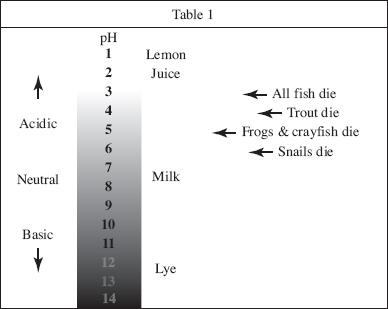
Study 1
A specially designed collection bucket was used to gather rain samples. The collector opened automatically during wet weather, allowing the precipitation to fall into the collection bucket, and then closed as soon as the precipitation stopped. The sample was then taken to a laboratory, where it was weighed and its acidity was measured. Finally, the concentrations of important inorganic chemicals found in the precipitation were analyzed. The results are shown in Table 2.
Table 2
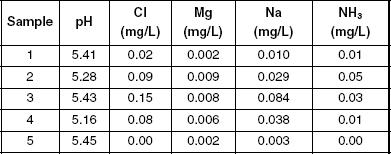
Study 2
Another study was done to compare the average pH of precipitation across various months. The same procedure was used as in Study 1, and the results are shown in Table 3.
Table 3
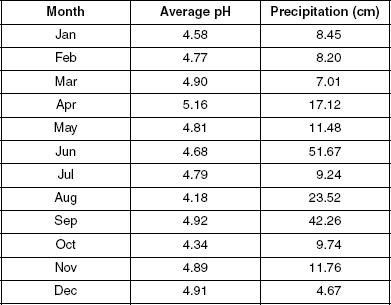
During which of the following months should there be the least concern for the health of frogs?
